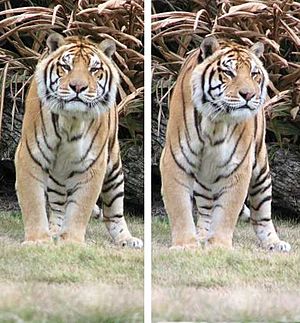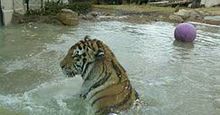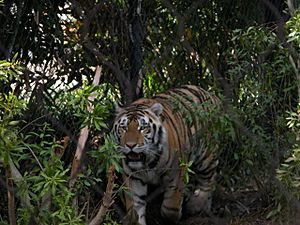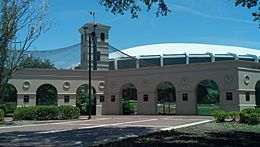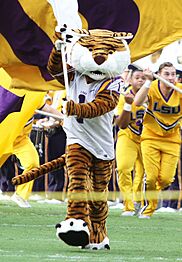Mike the Tiger facts for kids
Quick facts for kids Mike the Tiger |
|
|---|---|

Mike the Tiger in his habitat at LSU.
|
|
| University | Louisiana State University |
| Conference | SEC |
| Description | Royal Bengal tiger |
| Origin of name | In honor of athletic trainer Chellis "Mike" Chambers |
| First seen | October 21, 1936 |
Mike the Tiger is the official mascot of Louisiana State University (LSU). A mascot is a symbol that brings good luck. Mike represents LSU's sports teams and is a big part of the university's spirit.
There are two Mikes: a real, live tiger who lives on campus and a costumed mascot who cheers at games.
By tradition, the live mascot is a Bengal tiger. However, the last few Mikes have been mixed breeds. For example, the current tiger, Mike VII, is a mix of Bengal and Siberian tiger.
LSU's sports teams are called the Fighting Tigers and Lady Tigers. The nickname "Tigers" was first used in 1896. It honors brave Louisiana soldiers from the Civil War who were known as the "Tigers."
Contents
The Story of the Mikes
LSU has had a line of live tiger mascots since 1936. Each one has been named Mike.
Mike I (1936–1956)
The first Mike was bought from the Little Rock Zoo. LSU students raised $750 by each giving 25 cents. His original name was Sheik, but he was renamed to honor Mike Chambers, the school's athletic trainer. Chambers was the main person who worked to bring a tiger to LSU.
Mike I became the mascot on October 21, 1936. Once, before a big football game, some students from Tulane University took him as a prank. He was found and returned safely. Mike I lived for 20 years and died from kidney disease in 1956. You can see him today at LSU's Natural Sciences Museum.
Mike II (1956–1958)
After Mike I died, students raised money for a new tiger. Mike II was born at the Audubon Zoo in New Orleans. He was chosen because he had the biggest paws of all the cubs.
His time as mascot was short and a bit of a mystery. Some people believe he died from pneumonia shortly after arriving at LSU. They think the university secretly got another tiger to replace him. The school denied these rumors. The official story is that Mike II died in 1958 from pneumonia after breaking his leg.
Mike III (1958–1976)
Mike III arrived from a zoo in Seattle in 1958. This was just in time for LSU's national championship football season! During his 18 years as mascot, the football team had a lot of success.
He died of old age in 1976. His death made many people at LSU very sad. The vet at the time said he would never let another tiger pass away on campus again.
Mike IV (1976–1990)
Mike IV was born at Busch Gardens in Florida. He was two years old when he came to LSU in 1976. One night in 1981, some pranksters let him out of his cage. He wandered around for a few hours before being safely returned.
Mike IV was the mascot for 14 years. He retired in 1990 and went to live at the Baton Rouge Zoo. He was the oldest of all the Mikes, living to be 21.
Mike V (1990–2007)
Mike V was known for having the best personality of all the Mikes. He was donated by a zoological park in Alabama. He was just a small cub when he was introduced to LSU fans in 1990.
During his 17 years, the LSU football team won another National Championship in 2003. His home on campus also got a huge and beautiful renovation.
Mike V died in 2007 from kidney failure.
Mike VI (2007–2016)
After Mike V's death, some groups asked LSU not to get another tiger. But the university decided to continue the tradition. They explained that the Mikes lived long, healthy lives at LSU. They also said that raising tigers in places like LSU helps protect them, as they are an endangered species.
LSU found a young tiger named "Roscoe" at a rescue facility in Indiana. He arrived in Baton Rouge in August 2007. After making sure he was healthy and comfortable, he was officially named Mike VI.
In his very first year, the LSU football team won the National Championship! By 2015, Mike VI was a large tiger weighing over 420 pounds.
In 2016, vets found that Mike VI had a type of cancer that could not be cured. He lived comfortably in his habitat but no longer attended games. He was put to sleep by vets later that year to end his suffering.
Mike VII (2017–Present)
LSU decided to find another tiger to become Mike VII. The university announced that the new Mike would no longer be brought into the stadium on game days for his comfort and safety.
In August 2017, a 9-month-old tiger named "Harvey" was donated from a sanctuary in Florida. He arrived at LSU and was officially named Mike VII on the first day of the school year. In his third season as mascot, the LSU football team won the College Football Playoff National Title.
In 2021, Mike VII received two doses of the COVID-19 vaccine to keep him healthy.
Mike's Home on Campus
In 2005, a new $3 million habitat was built for Mike. It is one of the best tiger preserves in the United States. The habitat is a large, 15,000-square-foot space with grass, a waterfall, and a pond for swimming.
This amazing home is not just a place for Mike to live. It is also used for research and to teach people about tiger conservation. Fans can even watch Mike online through a live "Tigercam."
Fun Traditions
- Game Day Roar: A popular belief at LSU is that for every time Mike roars on a game day, the football team will score a touchdown.
- Graduation Pictures: Many students take a picture with Mike on their graduation day. It's a special memory for them.
- Visiting the Opponent: Until 2016, Mike's trailer was parked near the visiting team's locker room. This meant opposing players had to walk past him before the game! This tradition was stopped to ensure the tiger's comfort.
The Costumed Mascot
LSU also has a costumed mascot who is also named Mike. This Mike is a person in a tiger suit who attends all the sporting events, both home and away. The costumed Mike is very energetic and helps get the crowd excited.
A team of students helps the costumed Mike get to events and takes care of his costumes. This Mike is a very important part of the fun and spirit at LSU games.
See also


